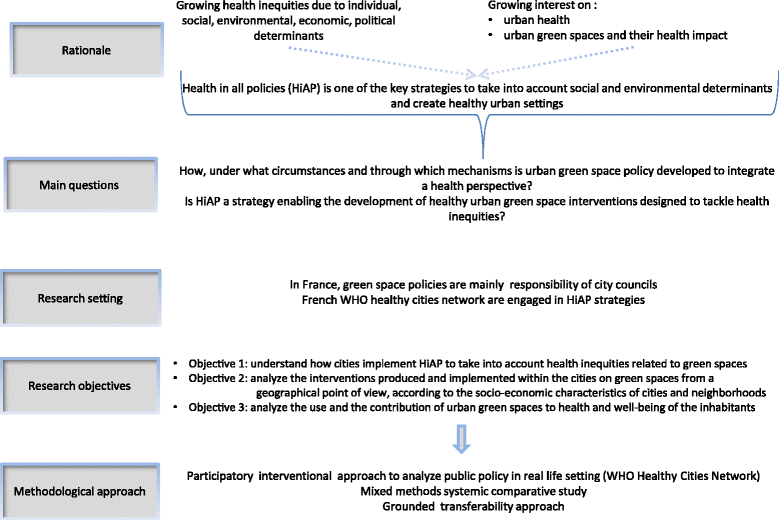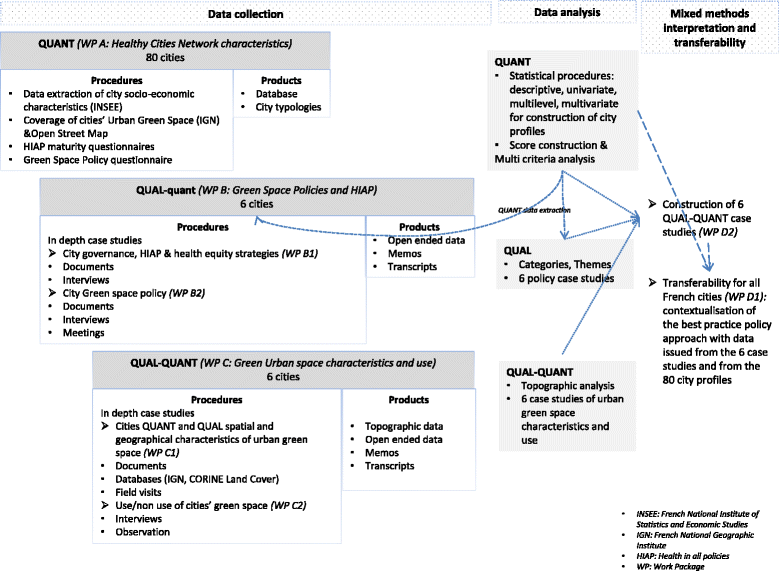The GREENH-City interventional research protocol on health in all policies
- PMID: 29047362
- PMCID: PMC5648502
- DOI: 10.1186/s12889-017-4812-8
The GREENH-City interventional research protocol on health in all policies
Erratum in
-
Correction to: The GREENH-City interventional research protocol on health in all policies.BMC Public Health. 2017 Nov 6;17(1):865. doi: 10.1186/s12889-017-4873-8. BMC Public Health. 2017. PMID: 29110654 Free PMC article.
Abstract
Background: This paper presents the research protocol of the GoveRnance for Equity, EnviroNment and Health in the City (GREENH-City) project funded by the National Institute for Cancer (Subvention N°2017-003-INCA). In France, health inequities have tended to increase since the late 1980s. Numerous studies show the influence of social, economic, geographic and political determinants on health inequities across the life course. Exposure to environmental factors is uneven across the population and may impact on health and health inequities. In cities, green spaces contribute to creating healthy settings which may help tackle health inequities. Health in All Policies (HiAP) represents one of the key strategies for addressing social and environmental determinants of health inequities. The objective of this research is to identify the most promising interventions to operationalize the HiAP approaches at the city level to tackle health inequities through urban green spaces. It is a participatory interventional research to analyze public policy in real life setting (WHO Healthy Cities).
Method/design: It is a mixed method systemic study with a quantitative approach for the 80 cities and a comparative qualitative multiple case-studies of 6 cities. The research combines 3 different lens: 1/a political analysis of how municipalities apply HiAP to reduce social inequities of health through green space policies and interventions 2/a geographical and topological characterization of green spaces and 3/ on-site observations of the use of green spaces by the inhabitants.
Results: City profiles will be identified regarding their HiAP approaches and the extent to which these cities address social inequities in health as part of their green space policy action. The analysis of the transferability of the results will inform policy recommendations in the rest of the Health City Network and widely for the French municipalities.
Discussion/conclusion: The study will help identify factors enabling the implementation of the HiAP approach at a municipal level, promoting the development of green spaces policies in urban areas in order to tackle the social inequities in health.
Keywords: Comparative multiple-case studies; Health in all policies; Health inequities; Interventional research; Mixed-methods; Transferability; Urban green spaces.
Conflict of interest statement
Ethics approval and consent to participate
The project will be carried out with full respect of current relevant legislation (e.g. the Charter of Fundamental Rights of the EU) and international conventions (e.g. Helsinki Declaration).
Consent for publication
Not applicable
Competing interests
The authors declare they have no competing interests.
Publisher’s Note
Springer Nature remains neutral with regard to jurisdictional claims in published maps and institutional affiliations.
Figures



References
-
- Chevreul K, Brigham KB, Durand-Zaleski I, Hernández-Quevedo C, Mckee M, Sagan A, et al. France : Health system review. Health Sys. 2015:17 http://www.euro.who.int/__data/assets/pdf_file/0011/297938/France-HiT.pdf - PubMed
-
- CSDH . Closing the gap in a generation: health equity through action on the social determinants of health. Geneva: Final Report of the Commission on Social Determinants of Health; 2008. - PubMed
MeSH terms
Grants and funding
LinkOut - more resources
Full Text Sources
Other Literature Sources

